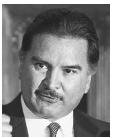GUATEMALA
Alfonso Antonio Portillo Cabrera
President

(pronounced "al-FOHN-soh an-TOE-nee-oh poor-TEE-oh ca-BRAR-ah")
"I have rejected the intervention of the state in the economy, the class struggle, the dictatorship of the proletariat. That was an era of romanticism in my life."
Guatemala lies between Mexico to its north, El Salvador to its south, Honduras to the southeast, and Belize to the east. Guatemala's territory, comprising 108,890 sq km (42,042 sq mi), touches both the Pacific Ocean and Caribbean Sea. Geographically, the country is divided into three regions. The Northern Plain, sparsely populated and covered largely by tropical rain forests, is the site of many ancient Mayan ruins, most notably Tikal. The Central Highlands, where most of Guatemala's 13.3 million people (2002 estimate) live, is a region dominated by a chain of mountains with many volcanoes, some of which are active. The beauty and climate of this region has given Guatemala the nickname "Land of Eternal Spring." The Pacific Lowland, a thin strip of land along Guatemala's 241 km (150 mi) of hot and humid southern coast, is largely farmland owned by a few families who grow sugar cane, bananas and cotton or raise cattle for agroexport. Guatemala City is the capital. Guatemala, with the largest population in Central America, is further distinguished by its large indigenous population, descendants of the Mayans, who compose about 43% of the country's total population. The Mayans belong to 22 language and ethnic groups. The remainder of the population (estimated at 55%) is known as ladino in Spanish (mestizo in English), because they have mixed blood ancestrally and have abandoned the dress and customs of the indigenous culture. Although Spanish is the official language, many indigenous people speak only their own language (including Quiche, Cakchiquel, Kekchi, Mam, Garifuna, and Xinca). While Roman Catholicism is the predominant religion, about one-third of the population is now affiliated with evangelical and Pentecostal churches. Many Mayans also continue to follow their ancient religious beliefs and practices, codified in their sacred writings, the Popul Vuh. Forty-five percent of the population is under 15 years of age and only 3% over age 65. Life expectancy among indigenous men is 47 years, compared to 64 for ladinos.
In this agrarian country, just 2% of the population owns 70% of the land. Agriculture contributes about 25% of the gross domestic product (GDP), over half of all exports, and employs nearly 60% of the labor force. Growth in the agricultural sector has been due to large-scale agribusiness concerns growing crops such as coffee, sugar, fruits (especially bananas) and vegetables for export. Ironically, Guatemala is an overall importer of food. The manufacturing sector is also divided into two components, a large traditional sector focused on such products as food, beverages, and tobacco, and a small but rapidly expanding enclave sector of assembly plants ( maquiladoras ) specializing in clothing and electronics. A large amount of Guatemala's trade occurs with the United States, Mexico, other Central American countries (especially El Salvador), and South Korea. The unit of currency is the quetzal. The per capita gross domestic product (GDP) was estimated at US $3,700 in 2001. More than 60% of Guatemalans live in poverty. A large percentage of Guatemalan children suffer from malnutrition; among the indigenous populations, three of every four children are seriously malnourished.
ADDRESS
Presidente de la Republica de Guatemala
Casa Presidencial
Guatemala City, Guatemala
Comment about this article, ask questions, or add new information about this topic: